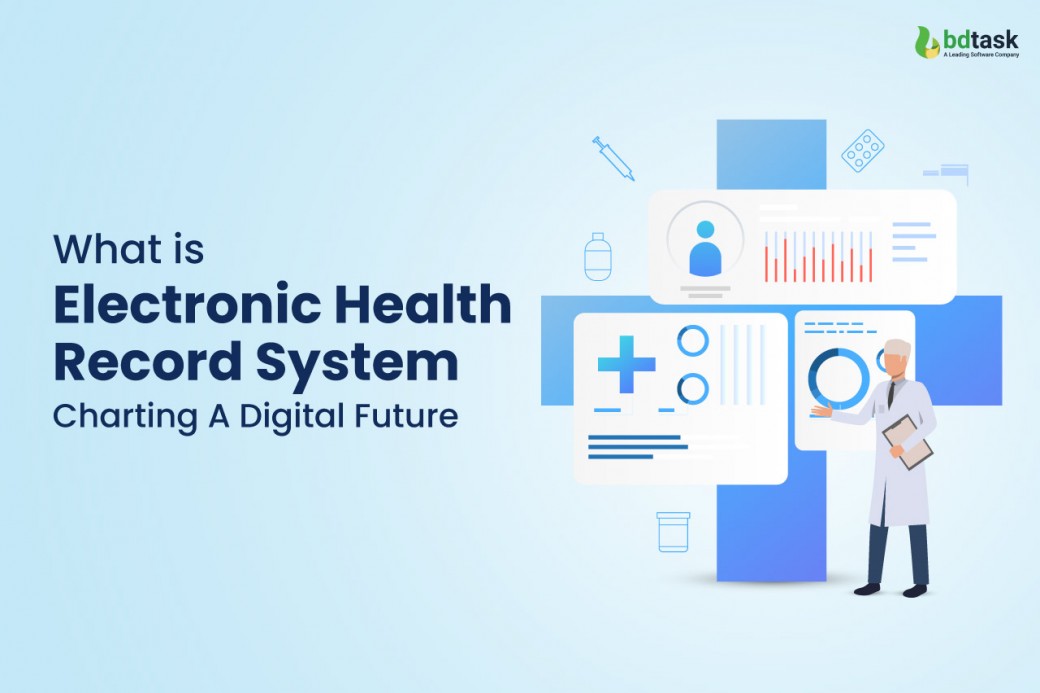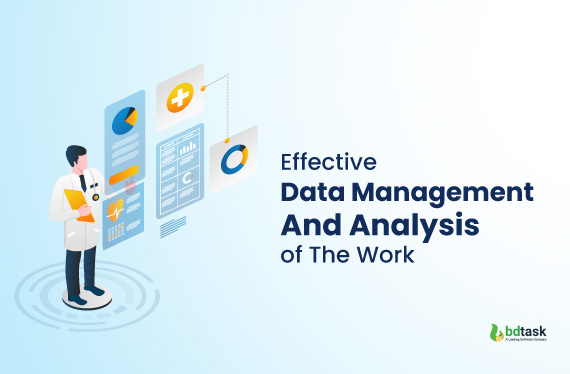What Is Electronic Health Record System-Charting A Digital Future

Today the medical world has migrated from paper-based records to digital-method of storing information. In that sense, Electronic Health Record systems have emerged as a transformative solution. Now a question arises in your mind what is electronic health record system?
The electronic health record is an integral part of our healthcare industry. The digital revolution played a major part in spreading awareness of EHR and its benefits to hospitals worldwide.
According to data from the CDC and ONC, 85% of all office-based physicians in the united states were using EHR solutions in 2017, and now it's growing rapidly.
The Electronic Health Record (EHR) system is one such innovation that has transformed how patient data is managed and shared.
Here we are going to cover
- Electronic Patient Record System
- What is Electronic Health Record System
- Evolution of Patient Record Management
- Types of Electronic Health Record Systems
- Benefits of Electronic Health Records
- Try Hospital Automanager, The Leading EHR System
Let's dive right into it.
What is Electronic Health Record System?
EHR=Patients Medical Histories in a Digital Format
Electronic Health Record (EHR) system is a digital platform that centralises and organises patient health information. Keeping patient records on physical documents has a lot of disadvantages.
- The documents can get lost.
- Moving patients' data from one place to another is inconvenient.
It encompasses a wide range of data, including medical history, diagnoses, medications, allergies, lab results, imaging reports, and treatment plans. It eliminates the need for paper-based records, allowing healthcare providers to access patient information instantly and efficiently.
EHR can improve patient care by
- Reducing the error by improving the accuracy of medical records
- Reduce the duplicate tests
- Reducing delays in treatment
- Help to reduce overall medical error
- And more
Unlike paper records, EHRs offer a comprehensive and up-to-date overview of a patient's health status, facilitating seamless coordination and collaboration among healthcare providers involved in the patient's care journey.
Evolution of Patient Record Management
Traditional patient record management relied heavily on paper-based systems, making accessing and sharing patient information with healthcare providers challenging. With the advent of EPR systems, the healthcare industry has witnessed a significant transformation in managing patient records. Electronic records have become the norm, replacing the cumbersome paper-based methods and offering numerous benefits.
What’s the Difference Between EMR and EHR system?

Scope and Purpose
EMRs focus on the patient's medical history within a single healthcare organisation. They provide a detailed account of diagnoses, treatments, medications, and test results, enabling healthcare providers to deliver care within their specific practice.
What is the purpose of the electronic health record?
EHRs have a broader scope, capturing a more comprehensive view of the patient's health across various healthcare settings. They facilitate coordinated and continuous care among multiple providers, ensuring a holistic approach to healthcare.
Data Accessibility and Sharing
EHR is designed for interaction, allowing authorised healthcare professionals from different organisations to securely access and exchange patient information. This seamless data sharing enhances care coordination and reduces duplication of tests or procedures.
EMRs are primarily accessible within the confines of a single healthcare organisation. They are not easily shared with other providers or institutions, which can limit the ability to exchange information when a patient receives care from multiple sources.
Interoperability
EMRs often utilise proprietary formats and standards, leading to interoperability challenges when integrating with other systems. Standardised data formats are needed to ensure information exchange between healthcare organisations.
EHRs follow standardised formats and employ Health Level Seven International (HL7) standards, making sharing data and communicating effectively between disparate systems easier.
Patient-Centered Care
While EMRs primarily serve the needs of healthcare providers, EHRs have a patient-centric approach. EHRs empower patients to access their health information, participate in care plans, and share decision-making with their healthcare providers.
EHRs encourage patient involvement and foster a collaborative relationship between patients and healthcare teams.
Legal and Regulatory Requirements
EMRs and EHRs must comply with various legal and regulatory requirements, such as privacy and security regulations. However, EHRs often have additional features and functionalities to meet stringent data protection standards. It ensures that patient information is safeguarded and confidentiality is maintained, especially when data is shared across different healthcare entities.
Types of Electronic Health Record Systems

What is EHR? What is an electronic health record system? You know the answer, and now time to learn what are the types of electronic health records.
There are many reputable EHR systems in the market today. They offer one design for clinical prescription, medical billing, practice management, outcomes, analytics etc. It may not be best for
Electronic health record systems have different variety of software. Let's explore all the types of electronic records systems largely.
1. The Ordinary EHR Systems
What is electronic health record system and what is an ordinary EHR system, what's the difference, we won’t rest until we find out!
Basic EHR systems are entry-level solutions that offer essential functionalities for healthcare organisations. They include patient demographics, medical history, appointment scheduling, and billing. These systems focus on core functionalities and are often used by smaller practices or clinics.
#Explore the Benefits and Applications#
Basic EHR systems provide healthcare providers with a centralised repository of patient information, improving accessibility and reducing paperwork. They streamline administrative tasks, enhance communication between healthcare professionals, and support accurate diagnosis and treatment planning.
2. Cloud-Based EHR Systems
Types of electronic health records-The cloud one
Cloud-based EHR systems store patient data on remote servers, allowing Access from any device with an internet connection. These systems offer scalability, flexibility, and cost-effectiveness, eliminating the need for on-premises infrastructure and maintenance.
#Find Out The Advantages Of Cloud-Based EHR Systems#
Cloud-based EHR systems enable seamless data sharing between healthcare providers, facilitate remote patient monitoring, and enhance collaboration among care teams. They offer automatic backups, robust security measures, and regular software updates.
#No 1 Concern About Security And Privacy #
While cloud-based EHR systems offer numerous benefits, data security and privacy concerns persist. Healthcare organisations must choose reputable vendors and ensure proper encryption, access controls, and compliance with data protection regulations.
3. Standalone EHR Systems
Types of electronic health records- Standalone EHR
Standalone EHR systems are independent software applications not integrated with other healthcare systems. They provide comprehensive functionalities, including patient records, clinical documentation, e-prescribing, and lab result management.
# Integration Challenges#
One drawback of standalone EHR systems is the need for interoperability with other healthcare applications. Integration with external systems like laboratory information systems or billing software may require additional customisation or interface development.
4. Open-Source EHR Systems
Types of electronic health records-Open-Source EHR
Open-source EHR systems are built on freely available source code, allowing users to modify and customise the software according to their requirements. These systems offer flexibility, transparency, and community-driven development.
#Benefits and Limitations#
Open-source EHR systems provide cost savings, flexibility, and the ability to adapt to evolving needs. They may require technical expertise for implementation and maintenance. When choosing an open-source EHR system, community support, active development, and vendor reputation are important factors.
5. Mobile EHR Systems
Mobile EHR systems enable healthcare providers to access patient data using smartphones or tablets. These systems often have dedicated mobile apps that offer functionalities like secure messaging, e-prescribing, and remote data entry.
#Enhancing Accessibility and Portability#
Mobile EHR systems increase accessibility and portability, allowing healthcare professionals to provide care outside traditional clinical settings. They improve communication, enable real-time data entry, and support point-of-care decision-making.
6. Mental Health EHR Systems
Types of electronic health records-Mental Health EHR
Mental health EHR systems are tailored to the specific needs of psychiatric practices and mental health facilities. They offer features like progress notes, treatment plans, outcome measurement tools, and integrations with telehealth platforms.
7. Oncology EHR Systems
Types of electronic health record systems-Oncology EHR Systems
Oncology EHR systems focus on the unique requirements of cancer care, including chemotherapy administration, tumour staging, treatment protocols, and survivorship planning. Oncology EHR Systems support multidisciplinary collaboration and provide comprehensive oncology-specific documentation.
8. Pediatric EHR Systems
Types of electronic health record systems- Pediatric EHR Systems
Pediatric EHR systems are designed to cater to the healthcare needs of children. They include growth charts, immunisation tracking, well-child visit templates, and age-specific clinical decision support. These systems improve pediatric care coordination and facilitate preventive healthcare.
9 Game-Changing Benefits Of Electronic Health Records

There are lots of benefits of Electronic Health Records in many ways. Not only for the patients but also for the providers, which include a wide array of societal, organisational, and clinical outcomes. Let's find some of the EHR benefits:
1. Better Patient Care-Quality Of Care
Electronic health records significantly improve patient care and safety. Access to complete and up-to-date patient management information allows healthcare providers to create more effective treatment plans, identify potential drug interactions or allergies, and avoid duplicate tests. Electronic health record systems also facilitate communication among healthcare teams, ensuring coordinated and seamless care.
2. Communication And Collaboration-Its Easy Now
EHR(Electronic health records) promote streamlined communication and collaboration among healthcare providers. Healthcare professionals from different disciplines and locations can easily access and share patient information through electronic records. It facilitates timely consultations, reduces redundant procedures, and improves care coordination for better patient outcomes.
3. Enhanced Efficiency and Accessibility of the working process
One of the primary benefits of electronic health records is the enhanced efficiency and accessibility they provide. With EHRs, healthcare providers can access patient information instantly, eliminating the need for time-consuming manual searches through paper records. This streamlines processes, reduces administrative burden, and allows more time for patient care.
4. Effective Data Management And Analysis of The Work

Electronic health records enable effective data management and analysis. With digital records, healthcare organisations can collect vast amounts of data, analyse trends, logistics management, and identify patterns for research and quality improvement initiatives. EHRs contribute to evidence-based medicine, enabling healthcare professionals to make data-driven decisions and improve healthcare delivery.
5. Accurate Patient Information-Save Space
Electronic health records enable effective data management and analysis. With digital records, healthcare organisations can collect vast data, analyse trends, and identify patterns for research and quality improvement initiatives. Electronic health record systems contribute to evidence-based medicine, enabling healthcare professionals to make data-driven decisions and improve healthcare delivery.
6. Cost Savings and Financial Benefits-No Labour Cost
Implementing electronic health records can lead to significant cost savings and financial benefits.
Cost reduction is one of the most significant benefits of EHR systems.
In particular, costs can be reduced through
- Decreased paperwork
- Improved safety and health
- Reduced duplication of testing
Which can happen when communication is troubled.
Using EHR is a win-win situation for any medical financial problem.
EHRs reduce paper and storage costs, eliminate the need for transcription services, and minimise administrative tasks. Streamlined workflows and improved efficiency can reduce hospital readmissions and improve resource utilisation.
7. Better Decision Making and Research Opportunities
Electronic health records systems empower healthcare providers to make better-informed decisions.
With Access to comprehensive patient data, clinicians can identify trends, monitor outcomes, and evaluate the effectiveness of various treatments. EHRs also facilitate research opportunities by providing a wealth of data for population health studies and clinical trials.
8. More Effective Privacy and Security
Privacy and security concerns are critical when it comes to electronic health records. Modern EHR systems employ robust security measures to protect patient data. They utilise encryption, user authentication, and audit logs to ensure confidentiality and compliance with privacy rules like the Health Insurance Portability and Accountability Act (HIPAA).
So you don't have to worry about breaching a patient's privacy as you provide their comprehensive care. These data protection make electronic patient data much more challenging for bad actors to access than paper records.
9. Generally Better Integration and Interoperability
Electronic health records offer the potential for integration and interoperability with other healthcare systems and devices. It allows seamless data exchange between hospitals, clinics, laboratories, and pharmacies. Interoperability enhances care coordination, reduces medical errors, and improves patient outcomes across various healthcare settings.
Try Hospital Automanager, The Leading EHR System
The best EHR system depends on your medical's size, budget, and goal. If you or your organisation is looking for the perfect EHR system, we should ensure you are on the right track!
Want an EHR solution that does it all?
To Conclude
Electronic Health Record systems have transformed the healthcare industry by digitising and centralising patient information. After understanding what is electronic health record system and all its benefits and potential to improve care coordination, patient engagement, and healthcare outcomes, EHRs have become invaluable tools for healthcare providers.
The future holds promising opportunities for EHRs to revolutionise healthcare delivery further and contribute to research and population health management. If proper steps are taken, and the EHR is adopted and utilised meaningfully, it can be a gift for patients, providers, and society.











